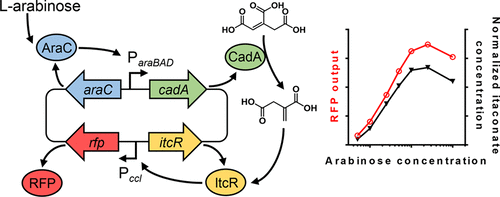当前位置:
X-MOL 学术
›
ACS Synth. Biol.
›
论文详情
Our official English website, www.x-mol.net, welcomes your feedback! (Note: you will need to create a separate account there.)
A Transcription Factor-Based Biosensor for Detection of Itaconic Acid
ACS Synthetic Biology ( IF 4.7 ) Pub Date : 2018-04-11 00:00:00 , DOI: 10.1021/acssynbio.8b00057 Erik K. R. Hanko 1 , Nigel P. Minton 1 , Naglis Malys 1
ACS Synthetic Biology ( IF 4.7 ) Pub Date : 2018-04-11 00:00:00 , DOI: 10.1021/acssynbio.8b00057 Erik K. R. Hanko 1 , Nigel P. Minton 1 , Naglis Malys 1
Affiliation

|
Itaconic acid is an important platform chemical that can easily be incorporated into polymers and has the potential to replace petrochemical-based acrylic or methacrylic acid. A number of microorganisms have been developed for the biosynthesis of itaconate including Aspergillus terreus, Escherichia coli, and Saccharomyces cerevisiae. However, the number of strains and conditions that can be tested for increased itaconate titers are currently limited because of the lack of high-throughput screening methods. Here we identified itaconate-inducible promoters and their corresponding LysR-type transcriptional regulators from Yersinia pseudotuberculosis and Pseudomonas aeruginosa. We show that the YpItcR/Pccl inducible system is highly inducible by itaconic acid in the model gammaproteobacterium E. coli and the betaproteobacterium Cupriavidus necator (215- and 105-fold, respectively). The kinetics and dynamics of the YpItcR/Pccl inducible system are investigated, and we demonstrate, that in addition to itaconate, the genetically encoded biosensor is capable of detecting mesaconate, cis-, and trans-aconitate in a dose-dependent manner. Moreover, the fluorescence-based biosensor is applied in E. coli to identify the optimum expression level of cadA, the product of which catalyzes the conversion of cis-aconitate into itaconate. The fluorescence output is shown to correlate well with itaconate concentrations quantified using high-performance liquid chromatography coupled with ultraviolet spectroscopy. This work highlights the potential of the YpItcR/Pccl inducible system to be applied as a biosensor for high-throughput microbial strain development to facilitate improved itaconate biosynthesis.
中文翻译:

基于转录因子的衣康酸生物传感器
衣康酸是一种重要的平台化学品,可以轻松地掺入聚合物中,并具有取代基于石油化学的丙烯酸或甲基丙烯酸的潜力。已开发出许多用于衣康酸生物合成的微生物,包括土曲霉,大肠杆菌和酿酒酵母。但是,由于缺乏高通量筛选方法,目前可以测试衣康酸滴度增加的菌株和条件的数量受到限制。在这里,我们从衣原体耶尔森氏菌和铜绿假单胞菌中鉴定了衣康酸酯诱导型启动子及其相应的LysR型转录调节子。我们证明YpItcR / P ccl诱导系统可被衣康酸在模型γ变形杆菌大肠杆菌和β变形杆菌Cupriavidus necator中高诱导(分别为215倍和105倍)。Yp ItcR / P ccl诱导系统的动力学和动力学进行了调查,我们证明,除了衣康酸酯,遗传编码的生物传感器还能够以剂量依赖的方式检测异麦康酸酯,顺式和反式花生酸酯。此外,基于荧光的生物传感器已在大肠杆菌中应用,以确定cadA的最佳表达水平,而cadA的产物可催化cadA的转化。顺式-衣康酸酯成衣康酸酯。荧光输出显示与使用高效液相色谱法和紫外光谱法定量的衣康酸酯浓度高度相关。这项工作突出了Yp ItcR / P ccl诱导系统作为生物传感器用于高通量微生物菌株开发以促进改善衣康酸酯生物合成的潜力。
更新日期:2018-04-11
中文翻译:

基于转录因子的衣康酸生物传感器
衣康酸是一种重要的平台化学品,可以轻松地掺入聚合物中,并具有取代基于石油化学的丙烯酸或甲基丙烯酸的潜力。已开发出许多用于衣康酸生物合成的微生物,包括土曲霉,大肠杆菌和酿酒酵母。但是,由于缺乏高通量筛选方法,目前可以测试衣康酸滴度增加的菌株和条件的数量受到限制。在这里,我们从衣原体耶尔森氏菌和铜绿假单胞菌中鉴定了衣康酸酯诱导型启动子及其相应的LysR型转录调节子。我们证明YpItcR / P ccl诱导系统可被衣康酸在模型γ变形杆菌大肠杆菌和β变形杆菌Cupriavidus necator中高诱导(分别为215倍和105倍)。Yp ItcR / P ccl诱导系统的动力学和动力学进行了调查,我们证明,除了衣康酸酯,遗传编码的生物传感器还能够以剂量依赖的方式检测异麦康酸酯,顺式和反式花生酸酯。此外,基于荧光的生物传感器已在大肠杆菌中应用,以确定cadA的最佳表达水平,而cadA的产物可催化cadA的转化。顺式-衣康酸酯成衣康酸酯。荧光输出显示与使用高效液相色谱法和紫外光谱法定量的衣康酸酯浓度高度相关。这项工作突出了Yp ItcR / P ccl诱导系统作为生物传感器用于高通量微生物菌株开发以促进改善衣康酸酯生物合成的潜力。


























 京公网安备 11010802027423号
京公网安备 11010802027423号